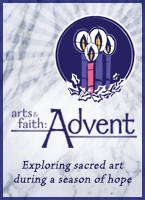Arts & Faith: Week 3 of Advent, Cycle A
Geertgen tot Sint Jans, “Saint John the Baptist in the Wilderness,” 15th century

In Geertgen tot Sint Jans’ Saint John the Baptist in the Wilderness, we meet the prophet in the wilderness. A lamb keeps him company as John sits on a jutting rock by a creek, heavily cloaked, deep in thought. Although known for his fiery passion, here we see a different side of St. John: introspective, prayerful, meditative. The scene brings to mind Christ’s own time in the wilderness, a time of prayer, trial, and temptation right after he meets St. John at the Jordan. Could it be that John was preparing the way for the Lord’s own trial in the wilderness?
Just as St. John might invite Christ into the wilderness, he also prepares the way for us to venture into our own wilderness. In the wilderness of our lives, we thirst for God’s grace the most. In our daily dry existence, any quick quench tempts us, even as we know that our thirst runs deeper. In the wilderness, St. John prepares the way by prayer; his struggle there is not against the corrupt king, but against the desire of his will. Before he preaches repentance and calls for justice, he prays and ponders his utter reliance on God. And even in the midst of this spiritual struggle, he finds that God’s grace already holds him; he is seated by a life-giving stream, and the lamb curls up close by, both symbols to demonstrate God’s presence.
In these days of Advent, we experience the already and the not yet. We are in the wilderness, yet the life-giving grace of God is always and already there. At the same time, we still await the fullness of glory, the ultimate quenching of our thirst. May our own lives of prayer prepare the way of the Lord within us as we await his coming.

Commentary is by Daniella Zsupan-Jerome, director of ministerial formation at Saint John's University School of Theology and Seminary.
Related Ignatian reflection on this week’s art
Week 3 of Advent, Cycle A

Personal Wilderness (Ages 9–11)
Explain to children that St. John sought wilderness as a calming place, because he felt connected to God when in nature. Ask children to imagine a setting where they can go to contemplate. Invite volunteers to share some of the details of their personal spaces, such as the color of the space, if the space is indoors or outdoors, if it is a known place or not yet discovered. Have children write a brief paragraph describing their personal wilderness, a place they can call their own to pray, mediate, think, and relax. Encourage children to draw a sketch of their personal wilderness and invite volunteers to share their finished drawings and descriptions.
Questions (Ages 12–15)
Point out to young people that St. John is contemplating and deep in thought in this work of art. Say: Often we may feel that there is so much to remember, to think about, to dwell on. It is important to allow our minds to wander over our thoughts, and to simply be. Have young people write a list of questions and thoughts they have in their minds. Remind young people that this list is private and they do not have to share. Encourage young people to put on paper all that they think about, even if they don’t know the answers or what to think about a specific topic. Say: Let your thoughts just come to you, free of judgment. When you’re ready to think about one of your questions, ask God to join you. Encourage young people to meditate on or journal about their questions to better know themselves and God.

